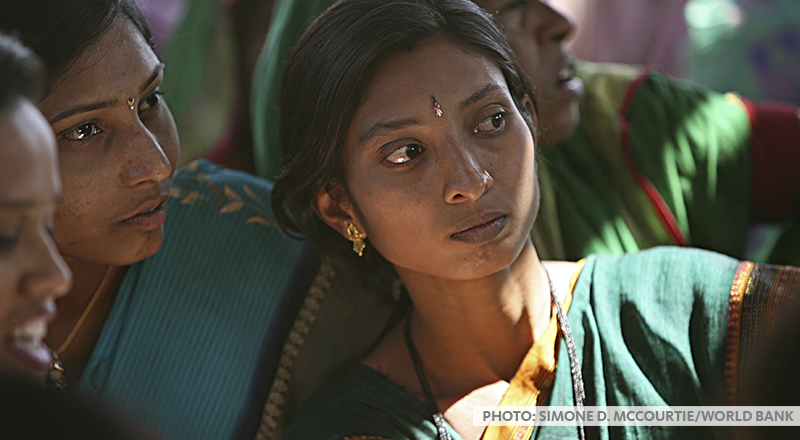
Health care practitioners around the world strive – oftentimes struggle – to provide women with adequate and deserved maternal and reproductive health care.
Sometimes they are hampered by a lack of resources, and women, mothers and babies die because they don’t get proper care. But the blame in some societies lies in health system failures and historical structures that discriminate against and disempower women.
Public health advocates have allies who may be continents afar: human rights lawyers and others who are critical to the global health movement.
In one landmark case, they held Brazil accountable for the death of Alyne da Silva Pimental Teixeira, an Afro-Brazilian woman who died of complications from pregnancy after a private and then a public health center denied her quality maternal care.
In 2011, a committee for the Convention on the Elimination of All Forms of Discrimination Against Women (CEDAW) -- often described as the “international bill of rights for women” – ruled that Alyne died because of “intersectional discrimination.” She was “discriminated against, not only on the basis of her sex, but also on the basis of her status as a woman of African descent and her socioeconomic background.” The CEDAW Committee also found that Alyne’s death violated the right to life under the International Covenant on Civil and Political Rights.
Alyne v Brazil was the first case on maternal mortality to be decided by an international human rights body, and it has played a critical role in advancing reproductive rights not only in Brazil but also in Latin America and around the globe.
“Human rights litigation brings attention to health campaigns and supports local and global movements and coalitions to improve women’s health,” said Jennifer Templeton Dunn, JD, a lecturer at UC Hastings College of the Law whose research, writing and advocacy focuses on women’s health and reproductive justice.
Dunn is lead author of an article in the peer-reviewed journal BMC Pregnancy and Childbirth, published in November 2017. Edited by the Women’s Health, Gender, and Empowerment Center of Expertise (COE) of the University of California Global Health Institute, the journal supplement, featured papers from multiple disciplines and varied methodologies, all responding to the central question of how women’s empowerment relates to pregnancy and childbirth.
Empowerment theme of publication
“We chose empowerment as the central theme of this issue because the relationship between women’s empowerment and pregnancy or childbirth, including abortion, has not received sufficient attention,” said COE Co-director Ndola Prata, MD.
Cases like Alyne v. Brazil “bring public awareness about the discrimination against poor or marginalized women in the health system, and provide leverage to civil society to make changes,” wrote Prata in the introduction of the special issue.
In their article, Dunn and her co-authors – Katherine Lesyna-Mlaponi, MS, alumna of the UCSF Master’s in Global Health program, and Anna Zaret, JD, graduate of UC Hastings College of the Law and a member of the UCSF/UC Hastings Consortium on Law, Science and Health Policy – examined several landmark cases in various parts of the world.
In K.L. v. Peru, medical providers denied a 17-year-old girl an abortion even though her doctors had determined that the fetus was anencephalic and would not survive past childbirth. “K.L.” gave birth to an anencephalic girl and was forced to breastfeed her for four days before the baby died. The birth and death of her daughter caused “K.L.” to suffer severe depression.
The United Nations Human Rights Committee in 2005 found that Peru had violated international and Peruvian law by not providing “K.L.” a mechanism for accessing legal abortion. It was the first abortion case decided by the United Nations Human Rights Committee and confirmed a state´s obligation to provide legal therapeutic abortion when the pregnancy poses mental or physical threats to a girl/woman, especially if she is a minor.
In another case in Peru – L.C. v Peru – doctors denied access to an abortion to a 13-year-old girl who had been repeatedly raped by a 34-year-old man. After becoming pregnant, “L.C.” attempted suicide by jumping off a building, severely injuring her spine.
“Her physicians recommended immediate surgery to repair her spine, which the hospital refused to provide, stating that back surgery would interfere with her pregnancy,” wrote Dunn and her co-authors. “L.C.’s" mother then asked the hospital to authorize an abortion. The hospital feared prosecution under Peru’s criminal abortion law and, therefore, refused to allow the abortion.”
“L.C. suffered a miscarriage, after which the hospital authorized the spinal surgery. However, the surgery was performed too late to avoid permanent damage to her spine, and, as a result, L.C. was permanently paralyzed from the neck down.”
In 2011, the CEDAW Committee, in its second major decision on the right to maternal health and abortion, agreed with human rights lawyers who argued that L.C.’s abortion should have been provided under the maternal health exception in Peru’s criminal abortion law.
The Committee also determined that "Peru had violated CEDAW provisions that require governments to end discrimination against women, provide equal protection under the law, protect women’s human rights, and specifically to eliminate gender-based discrimination in health care services,” wrote Dunn.
When Peru did not immediately act after the two decisions, public health advocates, doctors and lawyers began a continuous and concerted effort to demand that Peru implement recommendations by the UN Human Rights and the CEDAW Committees. In 2014, in response to this interdisciplinary pressure, Peru developed and published hospital guidelines for accessing legal abortion based on maternal health indications. In 2015, K.L. was finally compensated, and in March 2016, Peru formally apologized to L.C., acknowledging that the government and public health system had failed her.
Recent progress, but challenges ahead
With concerted efforts among UN agencies, national governments and civil society organizations, the maternal mortality ratio decreased worldwide by approximately 44 percent between 1990 and 2015, from 385 to 216 deaths per 100,000 live births, noted Dunn and her co-authors in their journal article.
Access to reproductive health care services improved from 1990 to 2015, they said. Efforts by the international community also have resulted in increases in the number of women in developing regions receiving the recommended four antenatal visits (35 percent to 52 percent), the proportion of deliveries worldwide with a skilled birth attendant (59 percent to 71 percent), and the global contraceptive prevalence rate (55 percent to 64 percent).
Despite these improvements, however, approximately 303,000 women died during childbirth in 2015, with 99 percent of the deaths occurring in developing countries. “While the number of maternal deaths remains high in many regions of the world, the majority of these deaths are preventable,” they wrote.
“Even with this progress, large inequities exist across and within regions, and there are still millions of women worldwide that lack access to basic reproductive health care services, including safe abortion.”
While human rights litigation can be a powerful force for change, practical limitations persist, Dunn acknowledged. “A specific enforcement mechanism for international decisions does not exist, and ensuring implementation of treaty body recommendations is often difficult,” she said.
Legal decisions may have little or no immediate impact for years, as was the case in Peru when a decade passed between the ruling in K.L. v. Peru and the government’s public acknowledgement and compensation of K.L., or even the “shorter” three years between the 2011 decision in L.C. v. Peru and the implementation of new abortion guidelines in 2014.
But persistence from the legal and human rights communities is crucial, even though rewards and gains may come painstakingly slow, said Dunn.
The journal article cited two cases in India in which its high courts ruled that public health services failed two impoverished pregnant women by denying them care to which they were entitled under the country’s existing health care and social services programs.
India had the second highest number of maternal deaths globally in 2015 and a maternal mortality ratio of 174 deaths per 100,000 live births, and it struggles when implementing various maternal health programs.
But the legal decisions exposed the failures in India’s health programs and “empowered a domestic campaign to ensure access to safe motherhood and reproductive health care services,” noted the journal article.
Thanks to the attention brought by the legal cases and persistent efforts by legal organizations, citizens groups and the public health sector to ensure implementation of services and demand accountability from the government, India continues to develop new maternal health programs that are desperately needed.
Partners in the effort
All the cases cited in the journal article demonstrate that human rights litigation can eventually bring about broad change.
“However, human rights lawyers cannot realize systemic change in isolation,” said Dunn. “Local civil society organizations and the public health community are integral to the successful implementation of a positive legal decision. These stakeholders all played critical roles in advocating for the government to fulfill its obligations and prioritize reproductive and maternal health.”
“The cases are a great example of why collaboration can be so important in this movement,” said co-author Katherine Lesyna-Mlaponi, who as a UCSF graduate student provided the global health perspective and researched the status of reproductive and maternal health globally.
“Health professionals provide health services, generate evidence and know the necessary interventions to reduce maternal mortality and improve reproductive health services,” said Lesyna-Mlaponi “Lawyers can raise awareness to the injustices of an individual, bring a face to the wider-scale problem, and hold governments and individuals accountable. Those cases can then be used to advocate for increased funding for the health sector or implementation of specific programs.
“In a way, just as we are providing lawyers with research and data to support their cases, they are also supporting us with a tool to advocate on a wider-scale and bring more attention and funding to an issue,” she said.
Lesyna-Mlaponi is now in Babati, Tanzania where she co-founded Thrive Afya Tanzania which works to improve access to quality reproductive and maternal health services for adolescents and women. “Tanzania is one of 10 countries that make up about 60 percent of global maternal deaths, so maternal mortality is a huge issue here,” she said. Her group is trying to change that.
And although there has been recent progress worldwide to improve maternal health and access to reproductive services, how do groups sustain the energy and effort when there are resource challenges and even continuing battles to save hard-won rights and programs?
“People have to decide that they care that women are dying during childbirth globally due to lack of access to quality services,” said Lesyna-Mlaponi. “Here is where I find the human rights aspect to be helpful. In a lot of these high-profile cases, the women who suffered and died due to discriminatory practices, lack of resources or inhibitive laws. They put a face and story to the statistics.”
“Their stories were brought out of the global health realm and into the consciousness of policymakers, who have the power to control how resources are allocated,” she said.
Indeed, the journal article concluded with: “The individual stories of these women, mothers, sisters, and wives call out for a health system and broader social and political structure where women’s health is important, women’s lives are valued, and life, rather than death, is the inevitable consequence of pregnancy and childbirth.”
